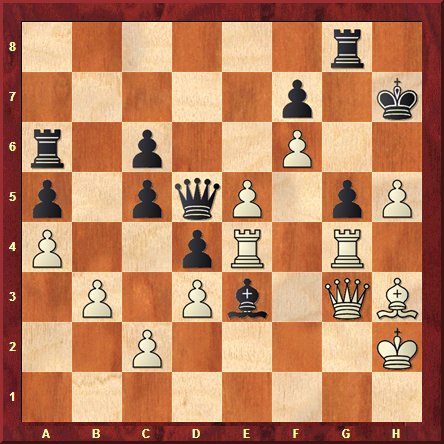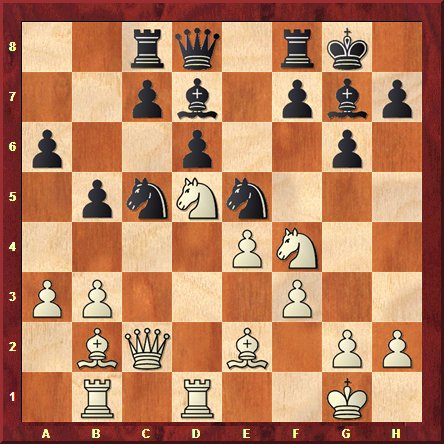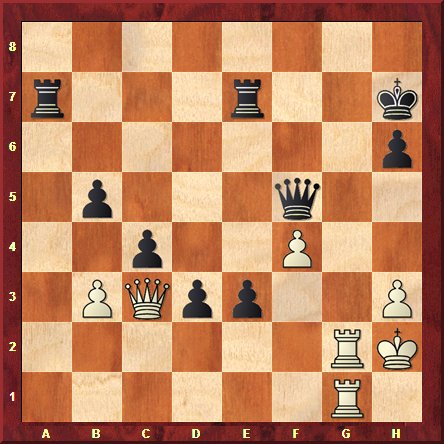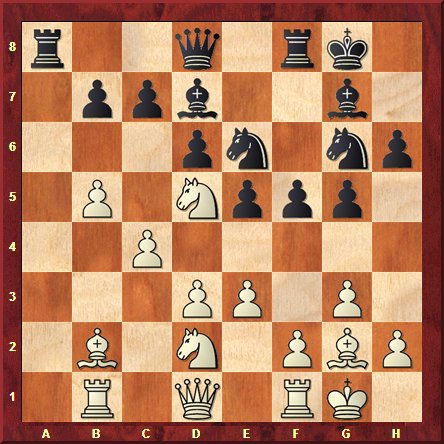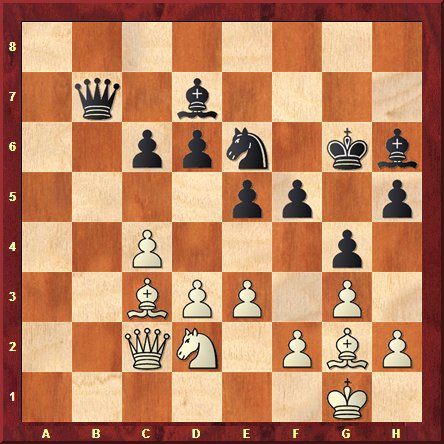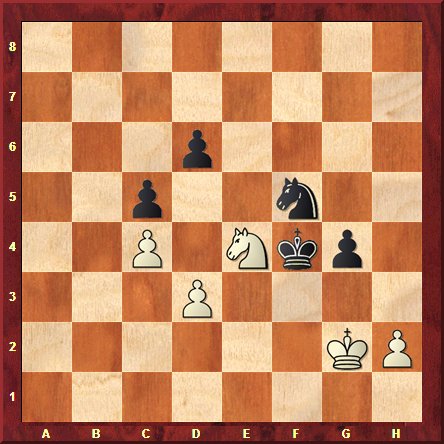All
the |
(Navigation bar
directly below.)
*******
© A.J. Goldsby, 2015.
(All rights reserved.)
****************
Click HERE
to see my
Chess Items.
****************
****************
Buy a book
from Amazon.com
(And help me out as well!)
****************
Click HERE
...
to see a list of the businesses that help to sponsor all of
my chess efforts.
|
|
|
On July 11th, 2015; Dothan (AL) held the "Clarence Kalenian Classic." (Click here to see the CT for this event.) ************************************************************** Many
of my fans have requested that I show my games, especially as CG
is no longer posting them. |
A.J. Goldsby I (2204) -
Tim Bond (1805)
|
|
|
1r4k1/2q2ppp/r1pbp3/p1p5/Pn1pRP2/1P1P1QP1/2PB1PBP/4R1K1 w - - 0 21
White has a slight edge.
********************************************************************************************************************
White's next move leads to a position that contains the (so-called) <much dreaded?> opposite-colored Bishops,
most of the time, this will usually lead to a draw.
However, I allow it, seeing that I will have a strong initiative on the King-side.
21.Bxb4! Rxb4!?; 22.f5! e5[]; (Box.)
According to the computer, this was completely forced.
[ Losing outright was:
</=
22...exf5; 23.Re8+ Bf8;
24.Qxf5 Qd6; 25.R1e7!,
'+-'
which is winning easily for the first player here. ]
23.f6 g6; 24.Qg4 Qd8!?;
Looks good - at a first glance ... but is quickly refuted.
(Better was 24...R-QN1; but White was still much better.)
[ Better/best was: >/= 24...Rb8[]; (forced/box) ]
25.f4! Rb8; (Forced?)
Of course, if Black captures on f4, he loses his Queen to the simple tactic of Re8+.
26.fxe5 Bf8; 27.h4 h5; 28.Qf4, (Maybe - '!')
This was pretty good ... (maybe even best).
[ RR
28.Qg5!?, '±' (White
is much better here.)
I looked at this briefly with a young person - his Dad,
(analyzing with an app on his smartphone); said that
Qg5 was the best move. ]
28...Kh7; 29.g4 Bh6; 30.Qf3!?, (Maybe - '!')
I liked this, as my idea was to open as many lines as possible.
[ Also good was: (>/=) RR
30.g5 Bf8; 31.e6 Bd6;
32.Qf2, '+-' (White is winning.)
which is what the machine prefers here. (But might be harder to bring home the
full point - the slightly blockaded nature of the position and the presence of Bishops
of opposite colors ... makes it hard to find an easy way to win.) 30.g5, is the first
choice of several strong programs ... (including
Deep Fritz 14!). ]
During the next few moves, White continues the general plan of opening lines ...
30...hxg4; 31.Rxg4 Qd7;
32.Bh3 Qd5; 33.Ree4 Re8;
34.Qg3 Be3+!?; 35.Kh2! Rg8;
36.h5! g5;
Now it is time for the finishing touch.
|
|
6r1/5p1k/r1p2P2/p1pqP1pP/P2pR1R1/1P1Pb1QB/2P4K/8 w - - 0 37
White to move and win.
********************************************************************************************************************
At first glance, Black's position might appear to be rock-solid ...
White's next move simply destroys Black's defender of the dark squares.
37.Rxe3! dxe3; 38.Rxg5, '+-' (White has an overwhelming advantage here.)
Black Resigns ... the box shows that it is mate in seven moves - at most.
[ If 38...Raa8; then simply 39.Rg7+, wins. If then 39...Kh8; then simply 40.Qg5, is decisive.
And if Black exchanges on g5, (38...RxR/g5; and 39.QxR/g5); then he has no decent way
of defending against a mate-in-one on the key g7-square.]
(The computer shows that Black had to play 37...Kh6[]. However, this leaves Black a piece down, White simply plays 38.Re1 and 39.Rg1, winning easily.)
1 - 0
Cristopher Trees (1806) - A.J.
Goldsby I (2204)
[A01]
Clarence Kalenian Classic / Round
#02
Dothan, AL; (USA) /
July 11th, 2015.
[A.J.G.]
In the next round, I play a young Mr. Trees ... the first time I played him, (just a few years ago); he was rated some 500+ points lower!!!
1.d4 Nf6; 2.c4 e5; 3.dxe5 Ng4;
The Budapest Gambit. (I have several books on this particular opening.)
This is not one of my "regular" openings, I play it on occasion, though.
********************************************************************************************************************
White does not hold on to the Pawn but immediately gives it back for good development.
(Nh3 looks strange, but aims for the d5-outpost.)
4.e3 Nxe5; 5.Nh3!? g6!?;
(Older books give this as bad, Fritz evaluates the whole line as being dead equal.)
6.Nc3 Bg7; 7.Be2 0-0; 8.Nf4 d6; 9.0-0 Nbc6;
This is not a new position ...
All this had been played before in Jacimovic vs. Vasovski in 2002.
(Both players are rated 2200+ by FIDE.)
********************************************************************************************************************
White's next move aims for a later Q-side expansion with a possible b2-b4.
10.a3!? Na5!?;
Black attacks White's Q-side.
11.Qa4,
This was probably best.
[ Inferior was: </= RR 11.b3?! Nexc4!; 12.bxc4 Bxc3; "+/=" when Black wins a Pawn. ]
In the ensuing moves, Black wins a Pawn, but the box shows that (with correct play) White can win back the button and be OK.
(Obviously, White does not find all the best moves, I leave it to the avid reader to discover
{for themselves} exactly what these were.)
11...b6; 12.Rd1 Bd7;
13.Qc2 Naxc4; 14.Ncd5 b5!?;
15.Rb1 Rc8!?;
16.b3 Na5;
17.Bb2 Nb7!; 18.e4 Nc5;
19.f3 a6; '+/'
The second player is clearly better in this position.
|
|
2rq1rk1/2pb1pbp/p2p2p1/1pnNn3/4PN2/PP3P2/1BQ1B1PP/1R1R2K1 w - - 0 20
Black won a Pawn out of the opening - and was able to keep it here.
Now Black just tries to slowly improve his position.
20.Bd4 Ne6; 21.Be3 Nxf4;
22.Nxf4 Bc6; 23.Nd5 Bb7;
24.a4 c6; 25.Nf4 Qc7;
26.Rbc1 Qb8;
27.axb5 axb5;
28.Rd2 Ba8; 29.Rcd1 Rfd8;
30.Bf1 h6; 31.Nh3 Kh7;
32.Nf2 c5!; (Best.)
Even though this leaves the Black d-Pawn as being backward, it is the right move because it activates the Q-side majority.
33.Nd3 Nc6!; 34.f4!? Nd4; 35.Bxd4 Bxd4+; 36.Kh1?,
White drops a 2nd Pawn.
[ >/= 36.Nf2[], ]
It is easy to play Black's side of the board now, I just trade down and start shoving my central Pawns.
To my opponent's credit, he did not quit and even found a way to stir up a few decent tactical ideas.
36...Bxe4; 37.Re1 f5;
38.Qc1 Re8; 39.h3 Qb7;
40.Kh2 Re7; 41.Nf2 Bxf2!?;
42.Rxf2 d5;
43.Rfe2 d4;
44.g4 c4; 45.Bg2 Qd5;
46.gxf5 gxf5 ; 47.Rg1 Rcc7;
48.Qa3 Ra7; 49.Qb4 d3;
Right around here, my opponent was down to about one minute on the chess clock. (Or maybe less!)
50.Bxe4 fxe4; 51.Reg2 e3; 52.Qc3 Qf5; {Diagram, just below.}
We have reached a critical position here.
|
|
8/r3r2k/7p/1p3q2/2p2P2/1PQpp2P/6RK/6R1 w - - 0 53
Black has a nice mass of central Pawns, but White has good piece activity. (And lots of threats!)
********************************************************************************************************************
Now with his next move, White threatens a mate in one move.
53.Rg8 Qxf4+; 54.R1g3 Re5!?;
This wins, but the Rook check on a2 was immediately decisive here.
(I used a lot of time for my last few moves, so around here it was mutual time pressure - and a scramble. Exciting chess!!)
[ An improvement was: >/= RR 54...Ra2+!; 55.Kg1, (Best?)
(55.Kh1 Qf1+; 56.Rg1 Qxh3#.)
55...Qf2+; 56.Kh1 Qh2#. ]
55.Qb4 e2; 56.Rf8 Qxg3+!?;
Winning easily - of course!
(According to DF-14, when White simply promotes his Pawn, it's a mate in seven.)
57.Kxg3 e1Q+; ('-+') White quits.
(The first player will remain a whole Rook down here.)
0 - 1
(Round three.)
In
the next round, I lost to the eternal ca. However, I don't count games
lost ... played vs. a computer via remote control.
(One day maybe he will get busted
and the truth will be revealed. Until then, I just bide my time. Maybe one
of his
co-conspirators will come forward and confess?)
For the record, the opening moves were:
1.a3 Nf6; 2.c4 e6; 3.d3 d5; 4.Nd2 Be7; 5.g3 c6; 6.Bg2 0-0; 7.Ngf3 b6; 8.0-0 Bb7; 9.b4 Nbd7; 10.Bb2 a5; 11.Qb3 c5; 12.b5 d4; 13.h3,
"="
but White lost in around 50+ moves. 0-1
Bryan Tllis (2190) - A.J.
Goldsby I (2204)
[A01]
Clarence Kalenian Classic / Round
#04
Dothan, AL; (USA) /
July 11th, 2015.
[A.J.G.]
The last round was a very
hard-fought draw; at the end of the game, I still had around 10 minutes left,
while my opponent
only had a few seconds left on the chess clock.
1.Nf3 g6; 2.c4 Bg7; 3.Nc3 d6; 4.g3 e5; 5.Bg2 Nc6;
6.d3 h6;
7.Rb1 f5; 8.Nd2 a5; 9.a3 Nge7;
10.b4 axb4; 11.axb4 0-0; 12.b5 Nd4;
13.e3 Ne6; 14.Nd5 g5; 15.Bb2 Ng6;
16.0-0 Bd7;
A standard English-type position, White has a small pull due (mainly) to the open file on the Q-side.
|
|
r2q1rk1/1ppb2b1/3pn1np/1P1Nppp1/2P5/3PP1P1/1B1N1PBP/1R1Q1RK1 w - - 0 17
17.Ra1 g4; 18.Rxa8 Qxa8; 19.Qb1!? h5; 20.Nb4 Qb8;
21.Qa2 Ne7; 22.Nd5 Nxd5; 23.Bxd5 c6;
24.bxc6 bxc6; 25.Bg2 Qb7; 26.Bc3 Ra8;
27.Qc2 Qc8; 28.Rb1 Rb8; 29.Rxb8 Qxb8; 30.Qa2 Qb7;
31.Qa3 Bf8; 32.Qa1 Kf7; 33.Qc1 Bh6;
34.Qc2 Kg6;
And now - White really has no advantage at all.
|
|
8/1q1b4/2ppn1kb/4pp1p/2P3p1/2BPP1P1/2QN1PBP/6K1 w - - 0 35
35.Nb3 Qb6; 36.Bb2 c5; 37.Nd2 Bc6; 38.Qb3 Qxb3;
39.Nxb3 Bxg2; 40.Kxg2 f4; 41.exf4 exf4;
42.f3 Kf5; 43.Bc3 Bg7; 44.Bxg7 Nxg7;
45.Nd2 Ke5; 46.Ne4 Nf5; 47.fxg4 hxg4; 48.gxf4+ Kxf4;
And now - Black looks a little better ... but the game is drawn, due to the fact that there are not enough Pawns left on the board to win.
|
|
8/8/3p4/2p2n2/2P1Nkp1/3P4/6KP/8 w - - 0 49
********************************************************************************************************************
Black tries to pressure White and hope for a mistake, but White defends calmly and then trades off all of the buttons.
49.Kf2 Ke5; 50.Ke2 Nh4; 51.Ke3 Ng2+; 52.Kf2 Nf4;
53.Ke3 Nh5; 54.Nf2 Nf6; 55.Nh1 d5;
56.cxd5 Nxd5+; 57.Ke2 Kd4; 58.Nf2 Nf6;
59.Kd2 Ke5; 60.Kc3 Kd5; 61.Kd2 Kd4; 62.Ke2 Ke5;
63.Ke3 Kf5; 64.Ke2 Kf4; 65.Nd1 Nd5;
66.Nb2 Ke5; 67.Na4 Kd4; 68.Nxc5! Kxc5; 69.Kf2,
"="
(Equal position.)
Black offered a draw which was immediately accepted.
[ The last few moves could have been:
(RR) 69.Kf2 Kd4; 70.Kg3 Nf6;
71.h3 gxh3; 72.Kxh3
Kxd3; '=' (draw)
when Black's extra horse means nothing without any foot-soldiers on the chess board.
]
½ - ½
I felt like I had to start doing something like this. For one thing, the person who runs the "ChessGames" website is no longer posting any of my games. Since you cannot access my games anywhere else, I felt like I had to start posting my own games ... although I would rather be annotating GM games on this particular website. Thanks!
Click HERE to go/return to the page for my games.
Click HERE to go/return to my page for the latest annotated games.
Click HERE to go/return to my site map.
Click HERE to go/return to my Home Page.
Copyright (c) A.J. Goldsby I
Copyright © A.J.
Goldsby I; 1985 - 2014.
Copyright (c) A.J.
Goldsby, 2015. All rights reserved.
This page was created on: Wednesday; July 15th, 2015. It was last altered/edited on: Wednesday, July 29, 2015 01:46 AM .


